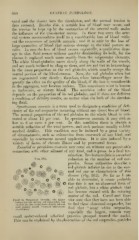Page 678 - My FlipBook
P. 678
688 GENERAL PA TIIOL00 Y.
canal and the tissues into the circulation, and the normal tension is
thus restored. Besides this, a notable loss of blood may occur, and
the tension be kept up by the contraction of the arterial walls under
the influence of the vaso-motor nerves. In these two ways the arte-
rial system accommodates itself to a considerable loss of blood with-
out the occurrence of notable anremia ; and it is only by the loss of
large quantities of blood tliat serious damage to the vital powers re-
In case the loss of blood occurs repeatedly, a qualitative dam-
sults.
age to that fluid results without notably diminishing its bulk, for the
])lasma is replaced much more readily than the corpuscular elements.
The white blood-globules move slowly along the walls of the vessels,
and are much inclined to cling to them, and are not lost in hemorrhage
in the Same proportion as the red globules, which usually occupy the
central portion of the blood-stream. Now, the red globules when lost
are regenerated very slowly ; therefore, when hemorrhages occur fre-
quently the eifect on the quality of the blood, if the loss is considerable
in the aggregate, may become serious. This constitutes what is known
as hydrccmia, or Avatery blood. The nutritive value of the blood
depends on the proportion of its red globules, and if these are deficient
a condition of debility results, no matter what the bulk of the circulat-
ing fluid.
SDontaneous ancvmia is a term used to designate a condition of defi-
ciency of the red corpuscles occurring without any direct loss of blood.
The normal pro])ortion of the red globules to the whole blood is esti-
mated at about 13 per cent. In spontaneous anaemia it may sink as
low as 6 or even 4 per cent. In this condition there is always a
notable reduction of the vital powers, and such patients usually exhibit
marked debility. This condition may be induced by a great variety
of circumstances, such as exhaustion from overwork of any kind, and
especially by continuous mental application. It is also induced by a
variety of forms of chronic illness and by protracted fevers.
Essential or pernicious ancemia may come on without any perceivable
connection with other ailment of any kind, and is prone to a fatal ter-
mination. Its characteristic is a marked
reduction in the number of red cor-
puscles. Some authorities describe a
red globule inferior in size to the nor-
mal red one as characteristic of this
disease (Fig. 382). So far as I am
able to determine, it seems probable
that this is not an abnormal form of
red globule, but a white globule that
has become stained with the coloring
matter of the red. Cornil and Ran-
Blood in Pernicious Anaemia: tiie larger vier state that they have not been able
bodies are the normal red corpuscles ; the
smaller are the round, more deeply colored to find these abnormal corpuscles, but
ones usually found—so-called niicrocytes
. find that " many white corpuscles,
(Kichhorst).
especially the largest, contain veiy
small amber-colored spherical granules grouped around the nuclei.
This can be explained by the/:lestruction of the red corpuscles, particles


